Physical Address
304 North Cardinal St.
Dorchester Center, MA 02124
On completion of this chapter, you should be able to :
Describe the embryology of the neural tube fetal brain development
Discuss the anomalies that can occur in the fetal head and spine
Recognize the sonographic appearance of fetal head and spine anomalies
The central nervous system (CNS) arises from the ectodermal neural plate at approximately 18 to 23 days gestation. The cephalic portion of the neural plate will differentiate into the primitive brain, and the caudal portion will form the spinal cord. As the neuropore folds and closes, three brain vesicles develop in the rostral cavity of the neural tube. These brain vesicles include the prosencephalon, mesencephalon, and rhombencephalon. The prosencephalon differentiates into the forebrain, the mesencephalon develops into the midbrain, and the rhombencephalon becomes the hindbrain. Unfused cranial and caudal neuropores will eventually close between 24 to 26 weeks of gestation. If the neural tube fails to fuse within 3 to 4 weeks of gestation, several malformations may be manifest, including anencephaly, encephalocele, and spina bifida.
At the end of the third week, the cephalic end of the neural tube will bend into the shape of a C (cephalic flexure), with the area of the mesencephalon having a very prominent bend. The brain then folds back on itself, and by the beginning of the fifth week another prominent bend, the cervical flexure, appears between the hindbrain and the spinal cord. The brain that originally was composed of three parts has now further divided into five parts. The prosencephalon divides into the telencephalon, which becomes the cerebral hemispheres, and the diencephalon, which eventually develops into the epithalamus, thalamus, hypothalamus, and infundibulum. The rhombencephalon also subdivides into the metencephalon, which ultimately becomes the cerebellum and pons, and the myelencephalon, which transforms into the medulla. The fundamental organization of the brain is represented in these five divisions that persist into adult life.
The primitive spinal cord divides into two regions. The alar plate region matures into the sensory region of the cord, and the basal plate region develops into the motor region of the cord. These regions further subdivide into specialized functions. During the first trimester, the spinal cord and the vertebral column extend the length of the body. After this, the growth of the spinal cord lags behind that of the vertebral column and the posterior portion the body grows beyond both vertebral column and spinal cord. At birth, the spinal cord terminates at the level of the third lumbar vertebra, although by adulthood, the cord will end at the level of the second lumbar vertebra.
Neural function begins at 6 weeks of gestation and commences with primitive reflex movement at the level of the face and neck. By 12 weeks of gestation, sensitivity has spread across the surface of the body except at the back and top of the head. The fetus begins to have defined periods of activity and inactivity at the end of the fourth month. Between the fourth and fifth months, the fetus can grip objects and is capable of weak respiratory movements. At 6 months of gestation, the fetus displays the sucking reflex, and by about 28 weeks, significant changes in brain wave patterns have occurred.
A wide range of defects may affect the fetal spine and/or brain. The remainder of this chapter presents anomalies of the CNS ( Table 60.1 ). Correctly identifying anomalies of the fetal head and spine can be a complex task. Some of the distinguishing characteristics that help to define specific anomalies are listed in Table 60.2 .
| Anomaly | Distinguishing Characteristics |
|---|---|
| Spina bifida |
|
| Cephalocele |
|
| Holoprosencephaly |
|
| Dandy-Walker complex |
|
| Agenesis of corpus callosum |
|
| Arachnoid/glioependymal cyst | Intracranial cyst with regular contours displacing/compressing cortex |
| Porencephaly | Intracranial cyst with jagged outline often communicating with lateral ventricles |
| Schizencephaly | Clefts in cortical mantle |
| Intracranial hemorrhage | Echogenic/complex mass in lateral ventricles/brain parenchyma |
| Microcephaly | Small head |
| Vascular malformations | Fluid-filled lesion with blood flow at Doppler examination |
| Craniostenosis | Abnormal skull shape |
| Lissencephaly | Absent/reduced cerebral convolutions |
| Infection | Intracranial/periventricular echogenicities |
| Anomaly | Sonographic Findings | Differential Considerations | Distinguishing Characteristics |
|---|---|---|---|
| Anencephaly |
|
|
No calvarium above vault orbits |
| Cephalocele |
|
Cystic hygroma | Defect in skull |
| Dandy-Walker malformation |
|
|
Cerebellar hemispheres will be splayed |
| Vein of Galen aneurysm |
|
|
Doppler flow in the cystic space |
| Porencephalic cyst |
|
|
No mass effect |
| Hydranencephaly |
|
|
|
Anencephaly may also be known as aprosencephaly or atelencephaly. It is the most common neural tube defect. The etiology of anencephaly is widely unknown and multifactorial with both environmental and genetic variables. Anencephaly may result from a syndrome, such as Meckel-Gruber (i.e., cystic kidneys, occipital encephalocele and/or polydactyly [postaxial], microcephaly, microphthalmia, cleft palate, and genitourinary anomalies), or a chromosomal abnormality, such as trisomy 13 and trisomy 18. Risk is increased in patients with diabetes mellitus, including those whose disorders are well controlled. Environmental and dietary factors, including hyperthermia, folate and vitamin deficiencies, and teratogenic levels of zinc, may also increase the prevalence of neural tube defects. Other teratogens associated with neural tube defects include valproic acid, methotrexate, and aminopterin. Another cause of neural tube defects is amniotic band syndrome, which may manifest with clefting defects.
Overall, the estimated prevalence of anencephaly is reported as 3 per 10,000 births. Due to its complicated etiology, incidence varies markedly among geographic locations, gender, ethnicity, and environmental exposures. A recurrence risk of 2% to 5% for subsequent pregnancies has been documented for a woman with a history of a prior pregnancy with an open neural tube defect. The recurrence risk can be reduced by 50% to 70% with use of folic acid supplements beginning 1 month before pregnancy.
Anencephaly, which means absence of the brain, is caused by a failure of the rostral end of the neural tube to close. During early development, a relatively normal brain forms, but it lacks both the calvarium and meninges. In time, mechanical and chemical influences of amniotic fluid on the exposed brain cause the brain to disintegrate and both cerebral hemispheres and skull fail to fully develop. As result, the base of the skull and facial structures are preserved, but there is a complete or partial absence of the cranium. The brainstem also remains but without the presence of a cerebrum, cerebellum, and basal ganglia. The remnant brain is covered by a thick membrane called angiomatous stroma or cerebrovasculosa.
Anencephaly is a lethal disorder, with up to 50% of cases resulting in fetal demise. The remainder die at birth or shortly thereafter. Because of the severity of this disorder, early diagnosis is preferred. Prenatal diagnosis is often made with ultrasound following referral for elevated maternal serum alpha-fetoprotein levels that occur because of the absence of skull and exposed tissue. Sonographic diagnosis of anencephaly during the first and second trimesters of pregnancies has approached 100%.
Anencephaly may be detected with ultrasound as early as 10 to 14 weeks of gestation. The brightly echogenic calvarium is missing beyond the forehead, and normal-appearing orbits and facial structures are retained. Variable amounts of disorganized brain tissue remain atop of the head, including mostly brainstem. The crown-rump length may be normal because degeneration of the fetal brain is progressive, leading to a reduction in the crown-rump length with advancing gestation. Second-trimester identification of anencephaly is more obvious.
Sonographic features of anencephaly include the following:
Absence of the brain and cranial vault ( Fig. 60.1 )
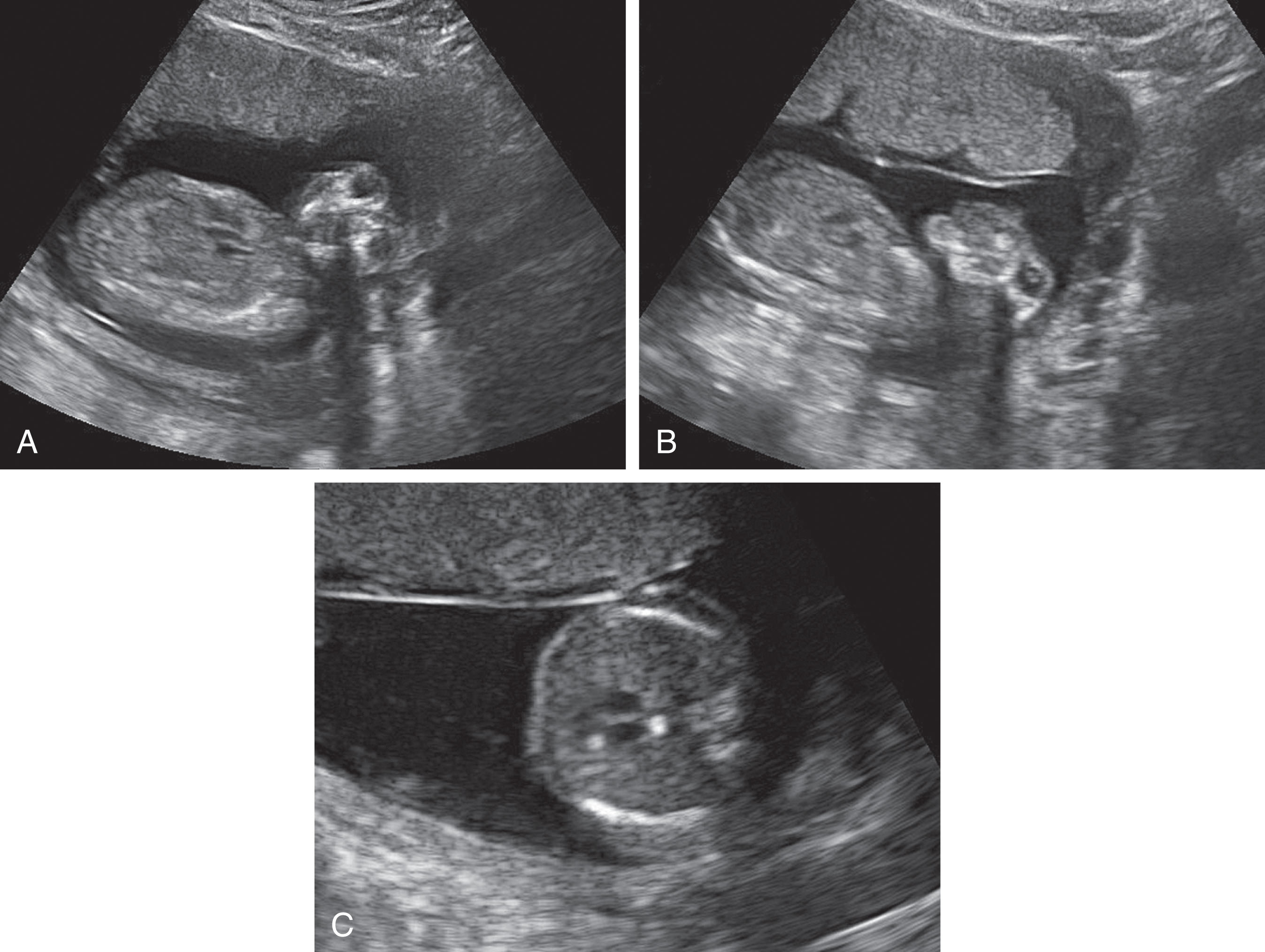
Rudimentary brain tissue characterized as the cerebrovasculosa ( Fig. 60.2 )
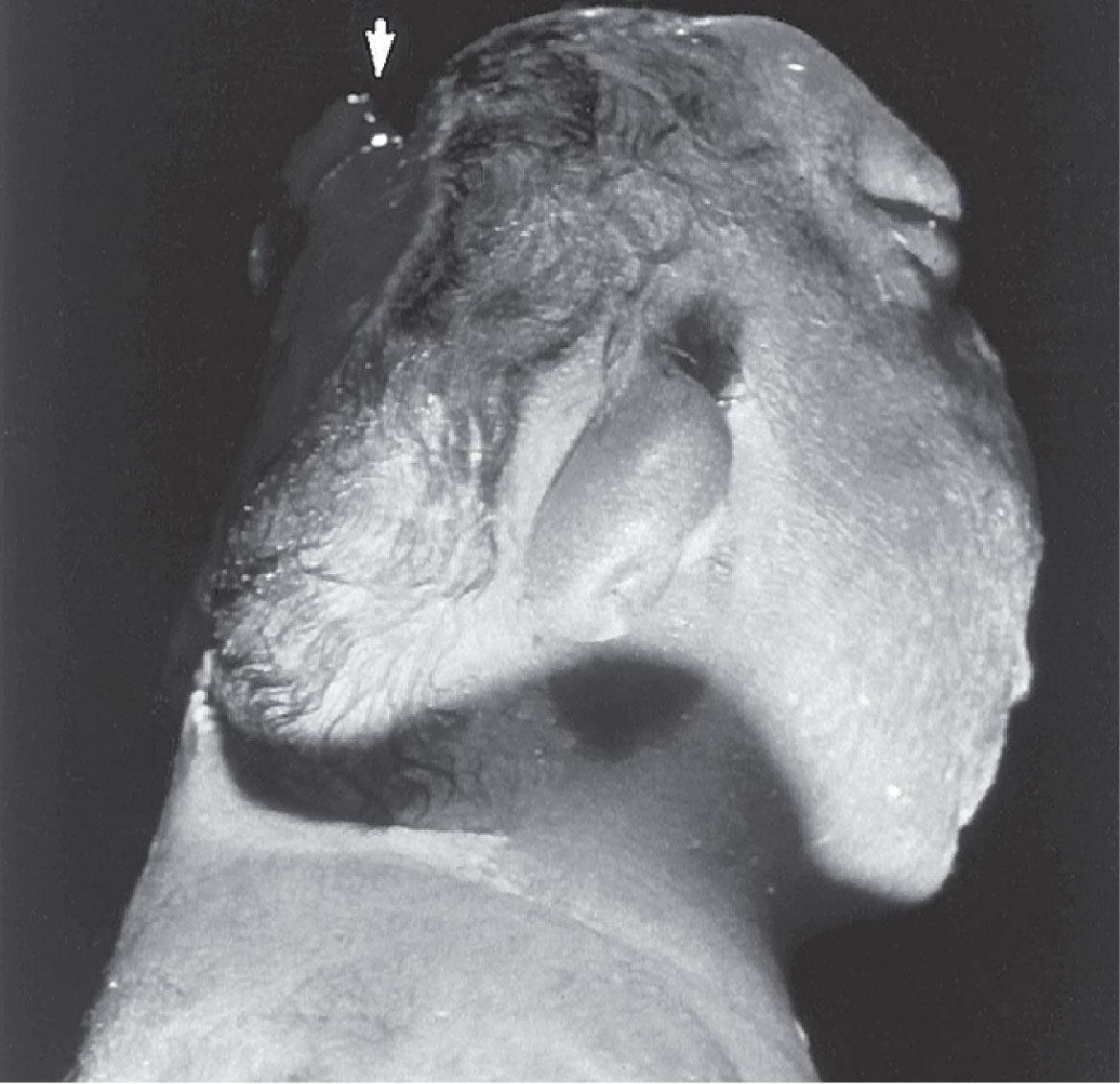
Bulging fetal orbits, giving the fetus a froglike appearance ( Fig. 60.3 )
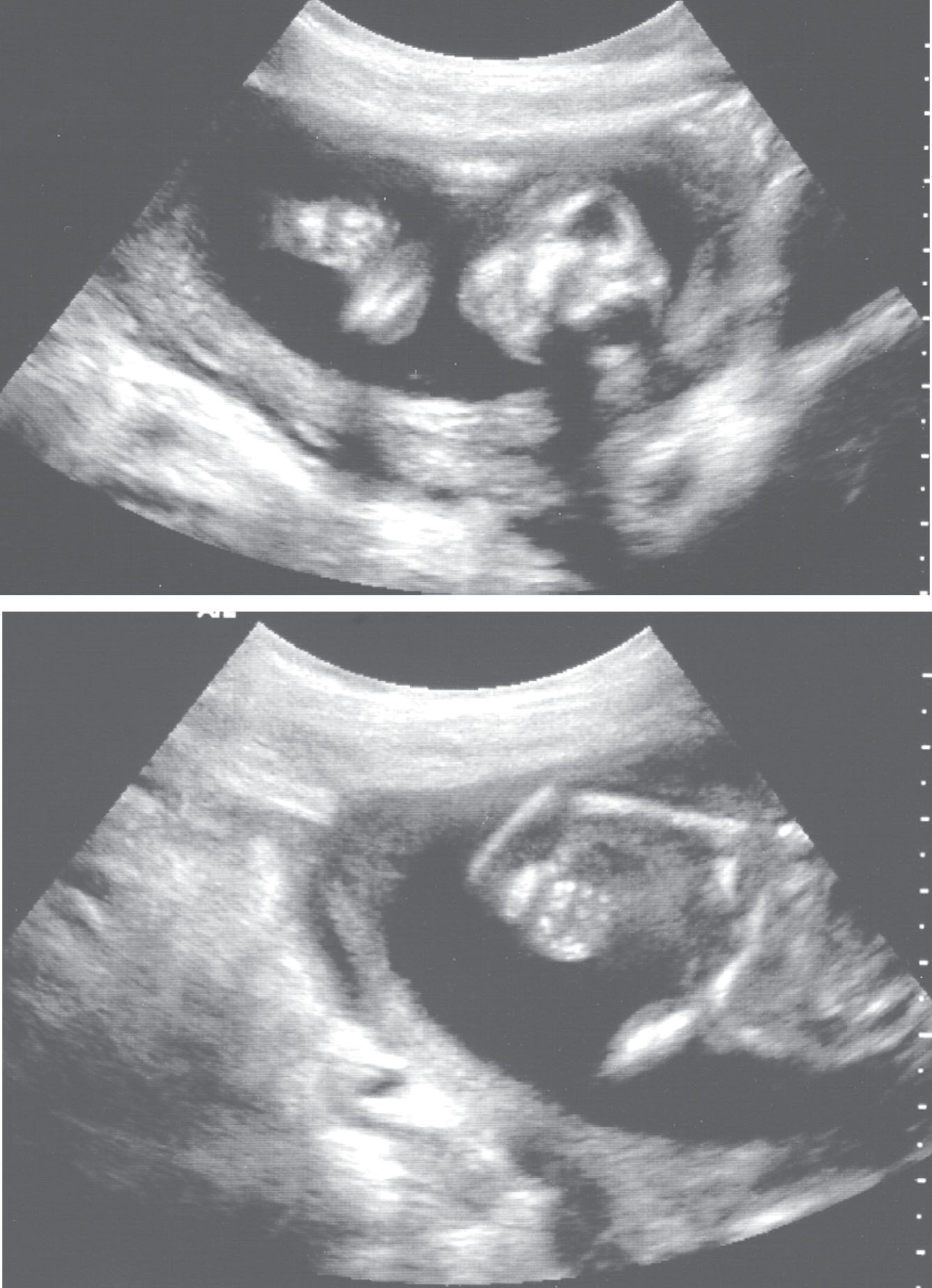
Other sonographic findings associated with anencephaly include polyhydramnios, which is commonly seen but may not be present until after 26 weeks of gestation. Echogenic amniotic fluid is best evaluated transvaginally or with increased overall gain. Coexisting spina bifida and/or craniorachischisis may be identified in fetuses with anencephaly. Additional anomalies include cleft lip and palate, hydronephrosis, diaphragmatic hernia, cardiac defects, omphalocele, gastrointestinal defects, and talipes.
When severe, microcephaly may be confused with anencephaly, although the presence of the cranium should aid in a definitive diagnosis. Other defects that may mimic anencephaly include cephalocele (brain herniation) and amniotic band syndrome (usually asymmetric cranial defects).
Acrania , or exencephaly, is the precursor for anencephaly and manifests as the absence of cranial bones in the presence of complete, although abnormal, development of the cerebral hemispheres. This anomaly occurs at the beginning of the fourth gestational week, when the mesenchymal tissue fails to migrate and bone does not form over the cerebral tissues.
Acrania may be confused with anencephaly, although the presence of significant brain tissue and the lack of a froglike appearance should establish the diagnosis. Other disorders that may mimic acrania include hypophosphatasia and osteogenesis imperfecta, both of which result in hypomineralization of the cranium. Identification of additional findings, such as long bone fractures, should help to distinguish these disorders from acrania.
Acrania is readily detected in the first trimester during nuchal translucency screenings. A fetus presents on ultrasound with a wide and irregular shaped head that lacks echogenic calvarium surrounding the brain. Sonographic landmarks for fetal head evaluation, appropriate for gestational age, are also difficult to decipher. Within the coronal plane, the cerebral hemispheres surrounded by amniotic fluid give the fetal head a bilobed appearance. This bilobed brain is best identified in the first trimester and has been described as a “Mickey Mouse” appearance.
Sonographic features of acrania include the following:
The presence of brain tissue without the presence of a calvarium ( Fig. 60.4 )
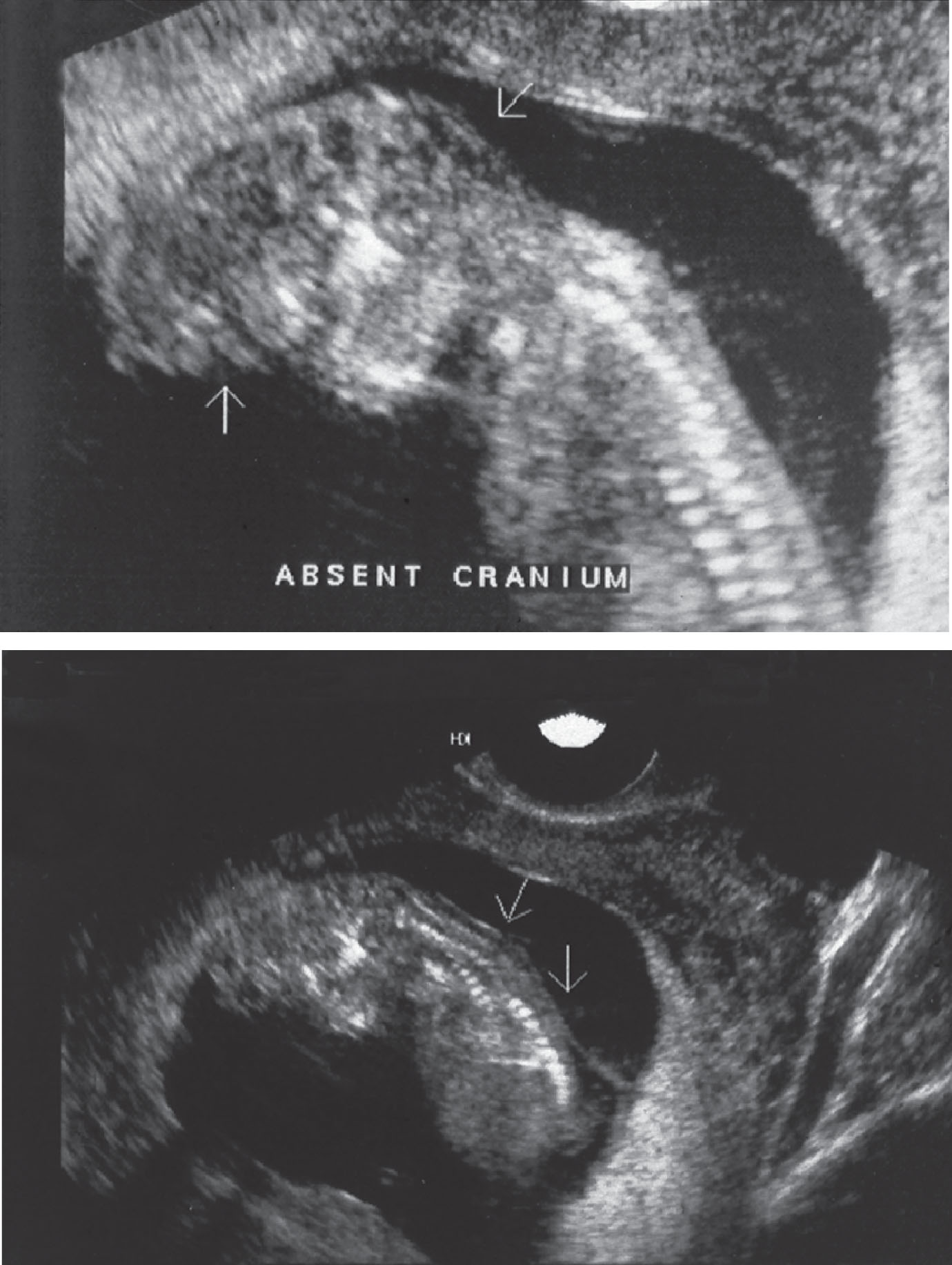
Disorganization of brain tissue
Prominent sulcal markings ( Figs. 60.5–60.7 )
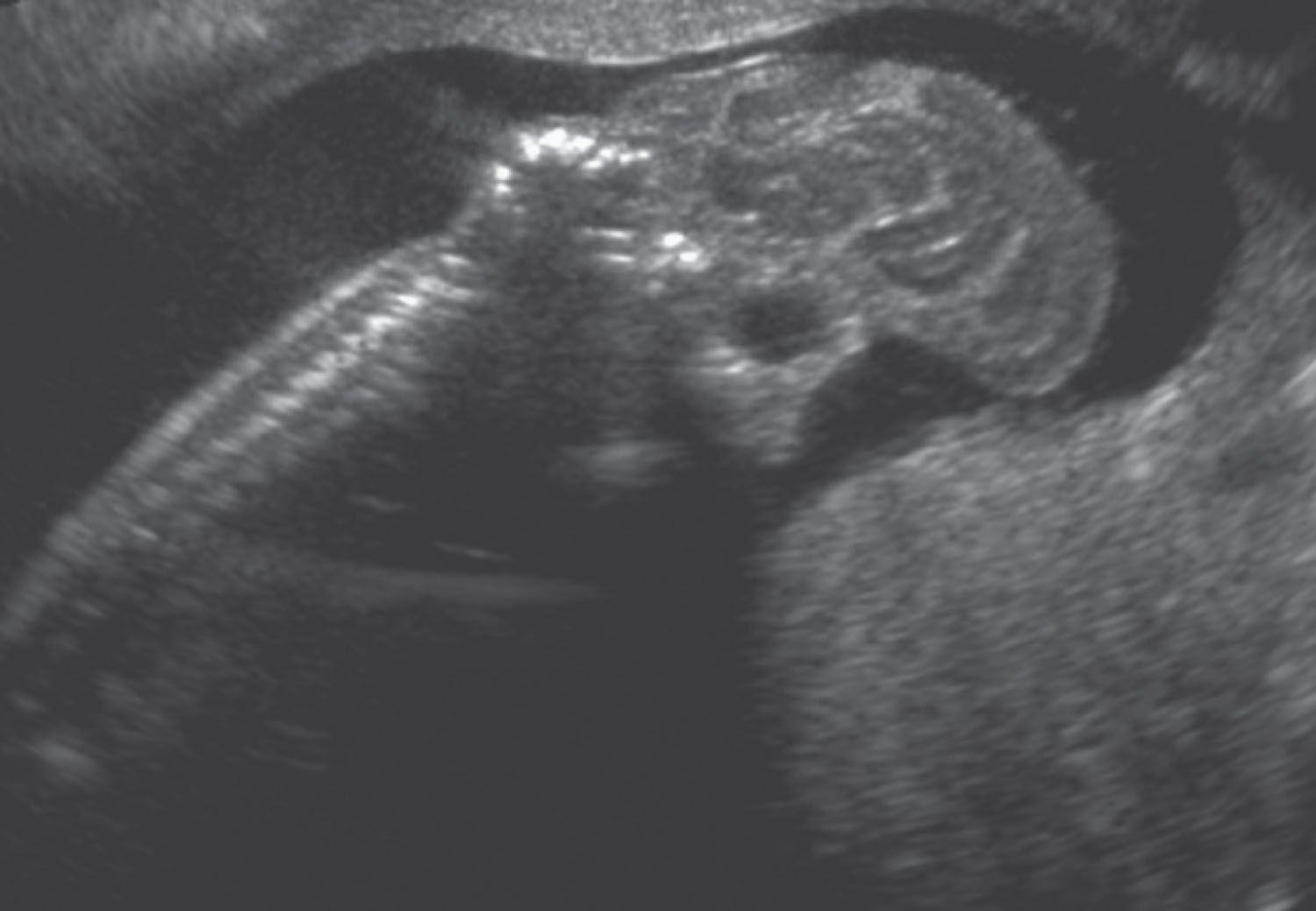
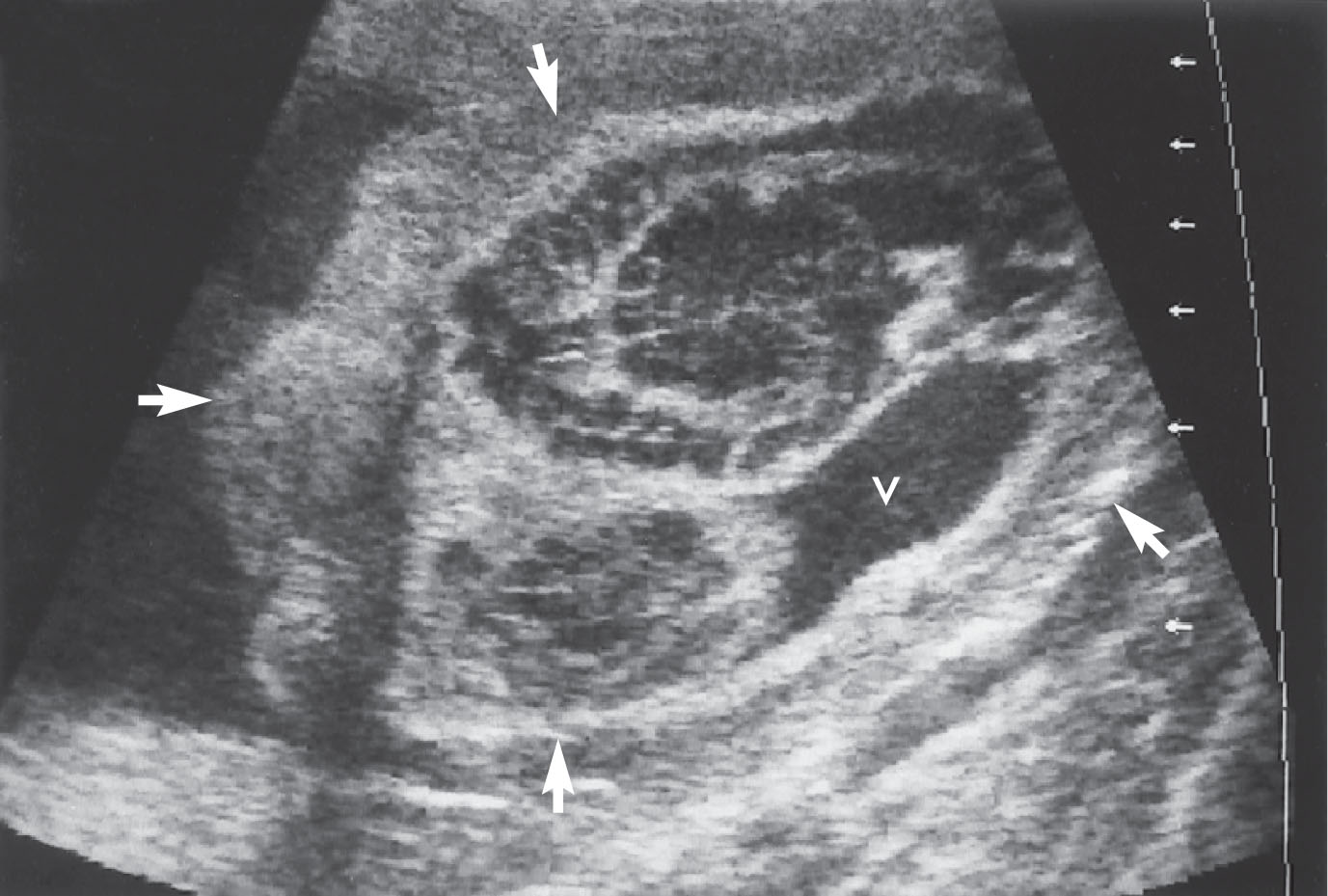
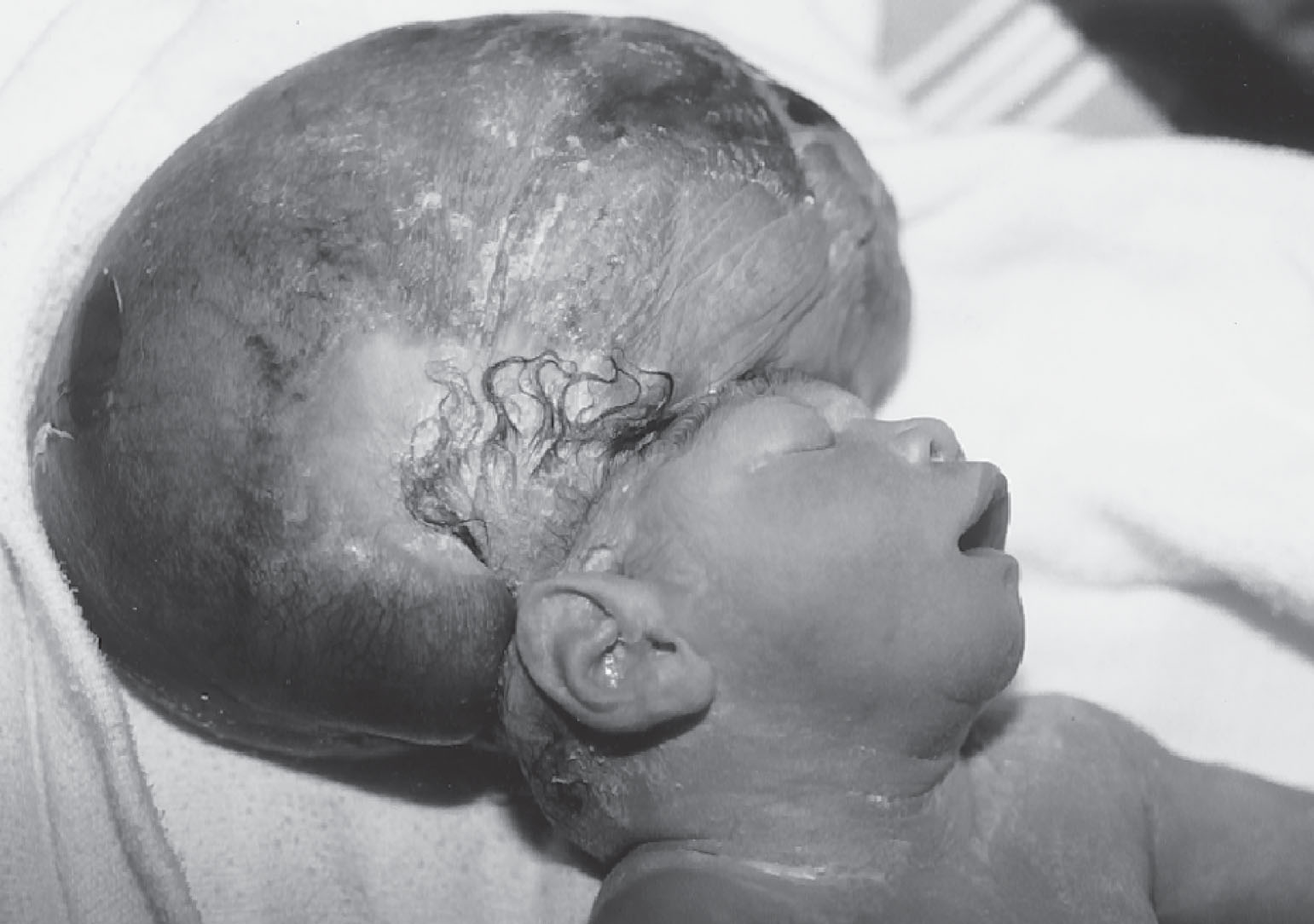
Acrania may be associated with other anomalies, including spinal defects, cleft lip and palate, talipes, cardiac defects, and omphalocele. Acrania has also been associated with amniotic band syndrome (see Fig. 60.4B ).
A cephalocele is a neural tube defect in which the brain, meninges, or both herniate through a defect in the calvarium. These malformations are classified according to their anatomic herniation and may occur in the occipital, frontal, temporal, and parietal regions of the fetal head. Encephalocele is the term used to describe herniation of the meninges and brain through the defect; cranial meningocele describes the herniation of only meninges ( Fig. 60.8 ). Overall, cephaloceles occur at a rate of 0.8 per 10,000 live births. Meningoceles are considered 10 times less common than encephaloceles. The incidence of different categorizations of cephalocele vary dependent on geographic location. The majority of cephaloceles in Europe and North America are occipital and posterior. Maternal serum alpha fetoprotein levels are likely within the low-risk range because the majority of encephaloceles are closed defects.
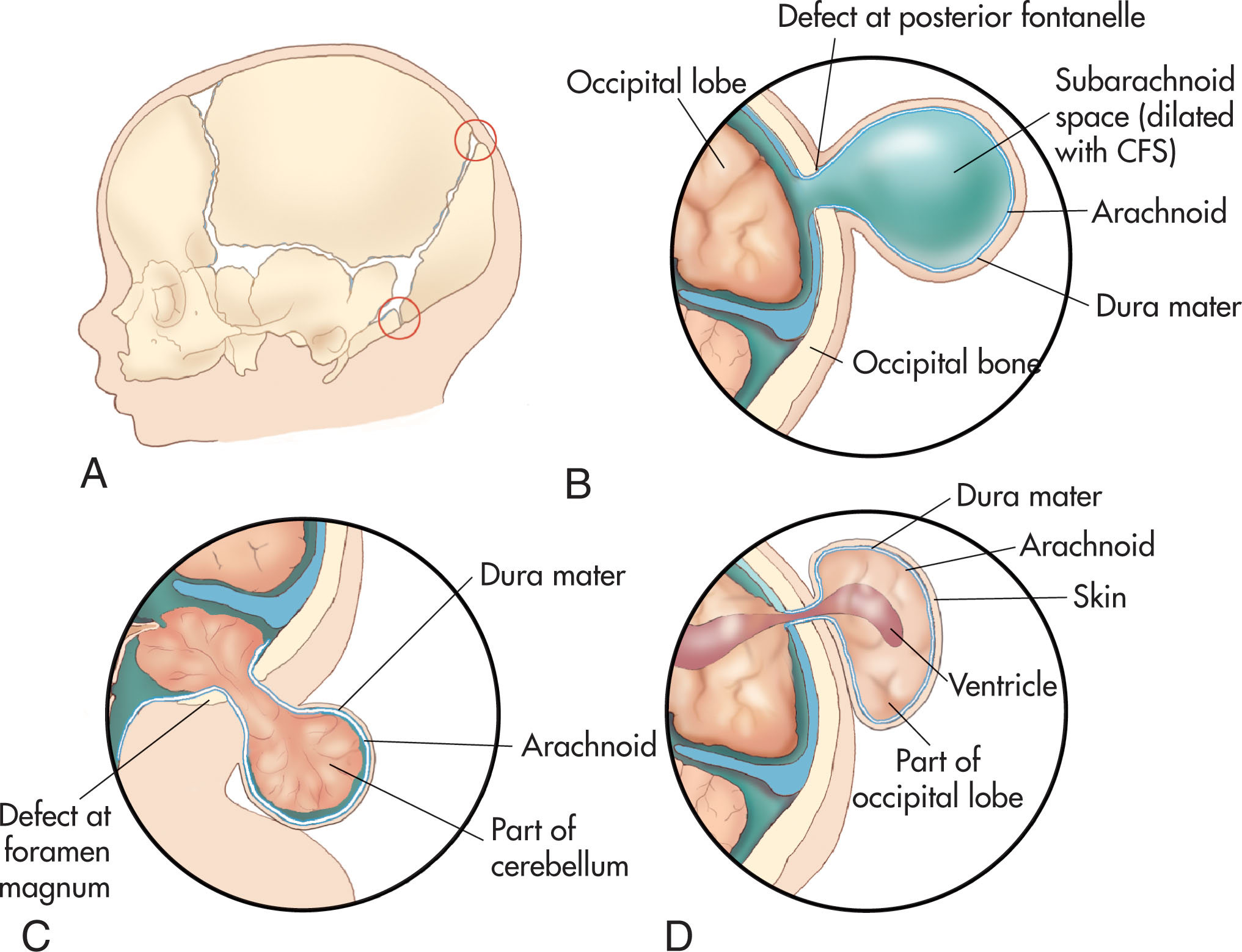
The prognosis for the infant with a cephalocele varies based on the size, location, involvement of other brain structures, and the presence of intracranial or extracranial malformations and microcephaly. Fetal death is common because of severe associated malformations and/or the inability to repair the defect. A giant encephalocele occurs when the protrusion is larger than the head from which it arises. Giant encephaloceles pose a significant surgical challenge. In addition, both preterm delivery and fetal growth restriction increase the risk for infant mortality. An infant with an isolated cranial meningocele has a chance of normal mentation; however, disabilities are common among surviving children.
The sonographic appearance of a cephalocele depends on the location, size, and involvement of brain structures. Cephaloceles are classified as occipital cephaloceles when the defect lies between the lambdoid suture and the foramen magnum; parietal cephaloceles occur between the bregma and the lambda; and anterior cephaloceles lie between the anterior aspects of the ethmoid bone. Anterior cephaloceles are further classified into frontal and basal varieties. The frontal cephaloceles are always external lesions that occur near the root of the nose. Basal cephaloceles are internal lesions that occur within the nose, the pharynx, or the orbit.
Most encephaloceles are diagnosed during the first trimester. The occipital lobes are most common in a posterior encephalocele, and the cerebellum may be present in very low posterior encephaloceles ( Fig. 60.9 ). The fetus often demonstrates a significantly smaller head circumference (HC) and biparietal diameter (BPD) when compared with the expected fetal age, and use of three-dimensional (3D) ultrasound in orthogonal planes and tomographic imaging assists in demonstrating the location, extent, and evidence of intracranial anatomy.
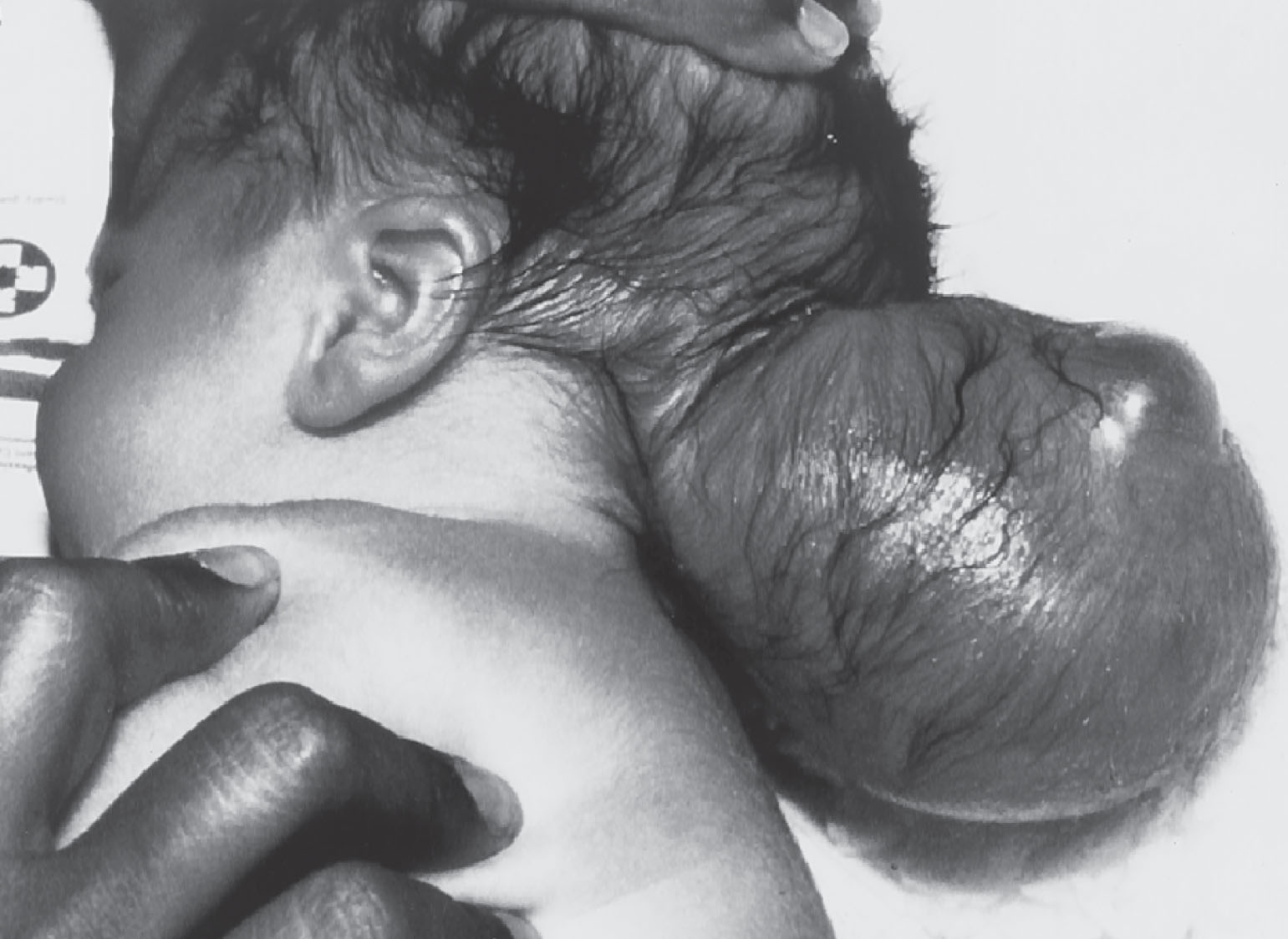
Sonographic features of cephaloceles include the following:
An extracranial mass ( Fig. 60.10 ), which may be fluid filled (cranial meningocele) or contain solid components (encephalocele)
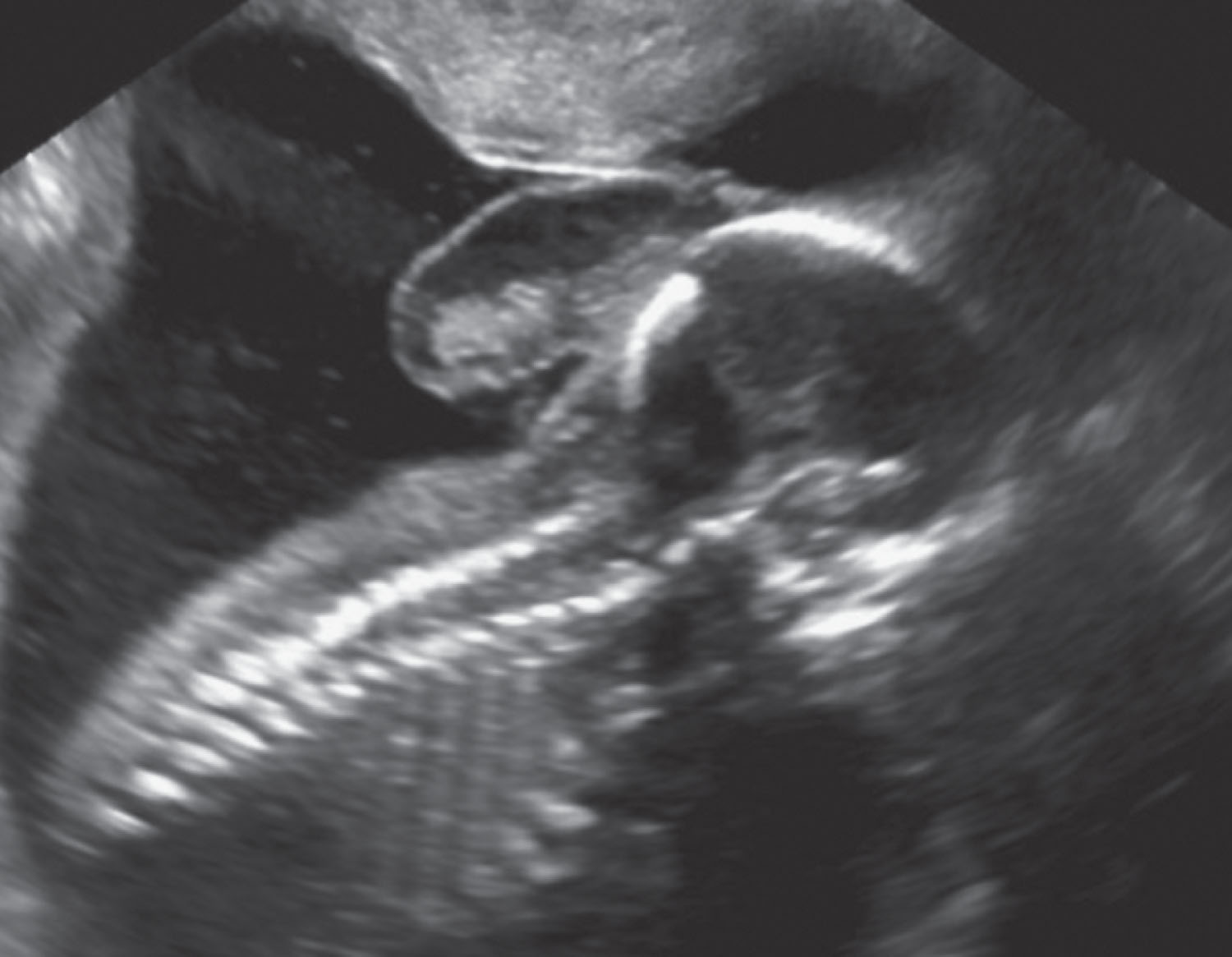
A bony defect in the skull
Ventriculomegaly, which is more commonly identified with an encephalocele
Smaller than expected HC and/or BPD
Another sonographic finding associated with cephaloceles is polyhydramnios. Coexisting anomalies include microcephaly, agenesis of the corpus callosum (ACC), facial clefts, spina bifida, cardiac anomalies, and genital anomalies. Chromosomal anomalies and syndromes have been identified with cephaloceles, including trisomy 13 and Meckel-Gruber syndrome, which is an autosomal recessive disorder characterized by encephalocele, polydactyly, and polycystic kidneys ( Fig. 60.11 ). Other syndromes linked with cephalocele include Chemke, cryptophthalmos, Knobloch, dyssegmental dysplasia, von Voss, Roberts, and Walker-Warburg. Cephaloceles located off midline are usually the result of amniotic band syndrome and may be further distinguished by associated limb anomalies and abdominal wall defects.
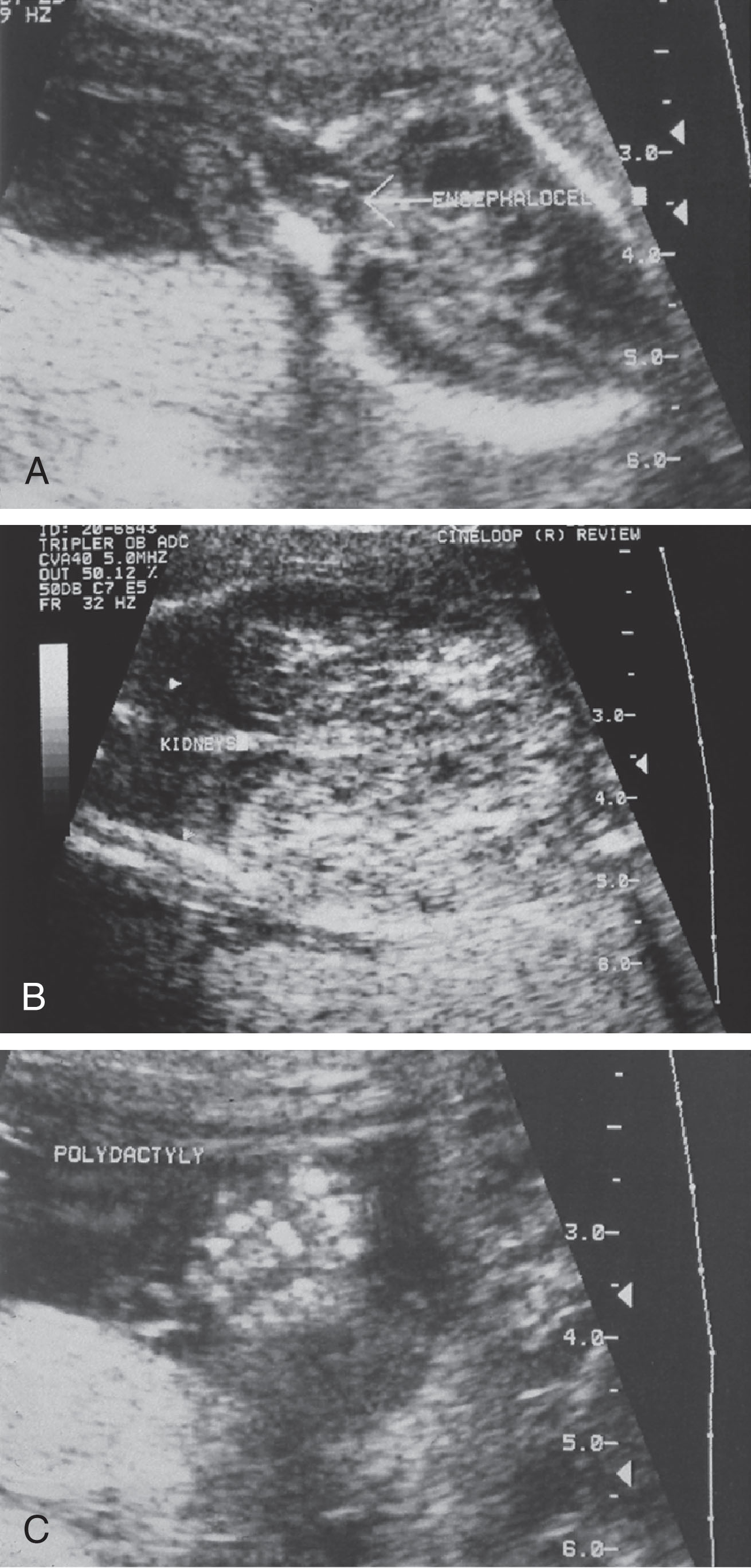
Cephaloceles must be distinguished from other midline masses and may be confused with cystic hygromas , although they lack a cranial defect. Anencephaly may be difficult to distinguish from encephaloceles of significant size, and the presence of the cranial vault with encephalocele should establish the diagnosis. Frontal encephaloceles may be difficult to distinguish from a facial teratoma.
Spina bifida encompasses a wide range of vertebral defects that result from failure of neural tube closure and incomplete fusion of the vertebral arches. The meninges and neural elements may protrude through this defect. The defect may occur anywhere along the vertebral column but most commonly occurs along the lumbar and sacral regions. Spina bifida etiology is complex with genetic, environmental, and/or drug-use factors. The incidence of this defect has declined as a result of campaigning by the US Public Health Service, which encourages women to increase their intake of folic acid before becoming pregnant, and the subsequent mandate by the Food and Drug Administration to add folic acid to cereal grain products. The estimated incidence in the United States is 3.50 per 10,000 live births.
The term spina bifida means that there is a cleft or opening in the spine ( Fig. 60.12 ). The two main categories of spina bifida include spina bifida aperta (open) and spina bifida occulta (closed). These two main categories are further divided based on whether the skin covers the defect, a herniated sac is present, and if there are multiple components found within the herniated sac. When covered with skin or hair, it is referred to as spina bifida occulta , an anomaly that is associated with a normal spinal cord and nerves and normal neurologic development. Spina bifida occulta is extremely difficult to detect in the fetus. Because the defect is covered by skin, the maternal serum alpha-fetoprotein level will be normal.
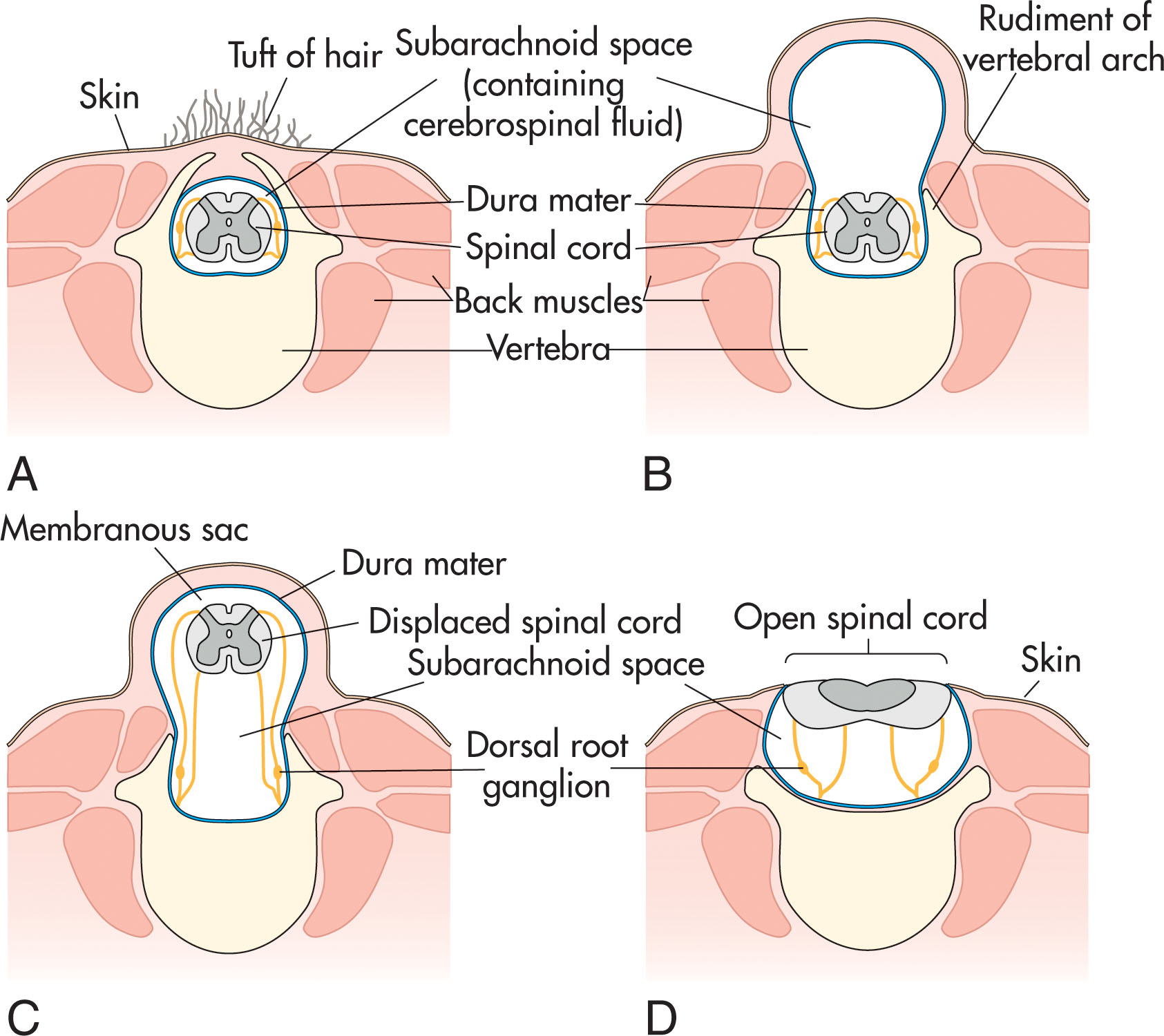
Spina bifida aperta has three clinical forms: meningocele, myelomeningocele, and myeloschisis. When the defect involves only protrusion of the meninges, it is termed a meningocele . More commonly, the meninges and neural elements protrude through the defect, called a meningomyelocele . The most severe form of spina bifida is termed myeloschisis (rachischisis). Myeloschisis ( Fig. 60.13 ) is a significantly large and severe defect including multiple adjacent vertebrae. Several variants include an adipose tissue component in addition to meningeal and/or neural components and are termed lipomyelomeningocele and lipomeningocele. Open neural tube defects are commonly associated with increased maternal serum alpha-fetoprotein.
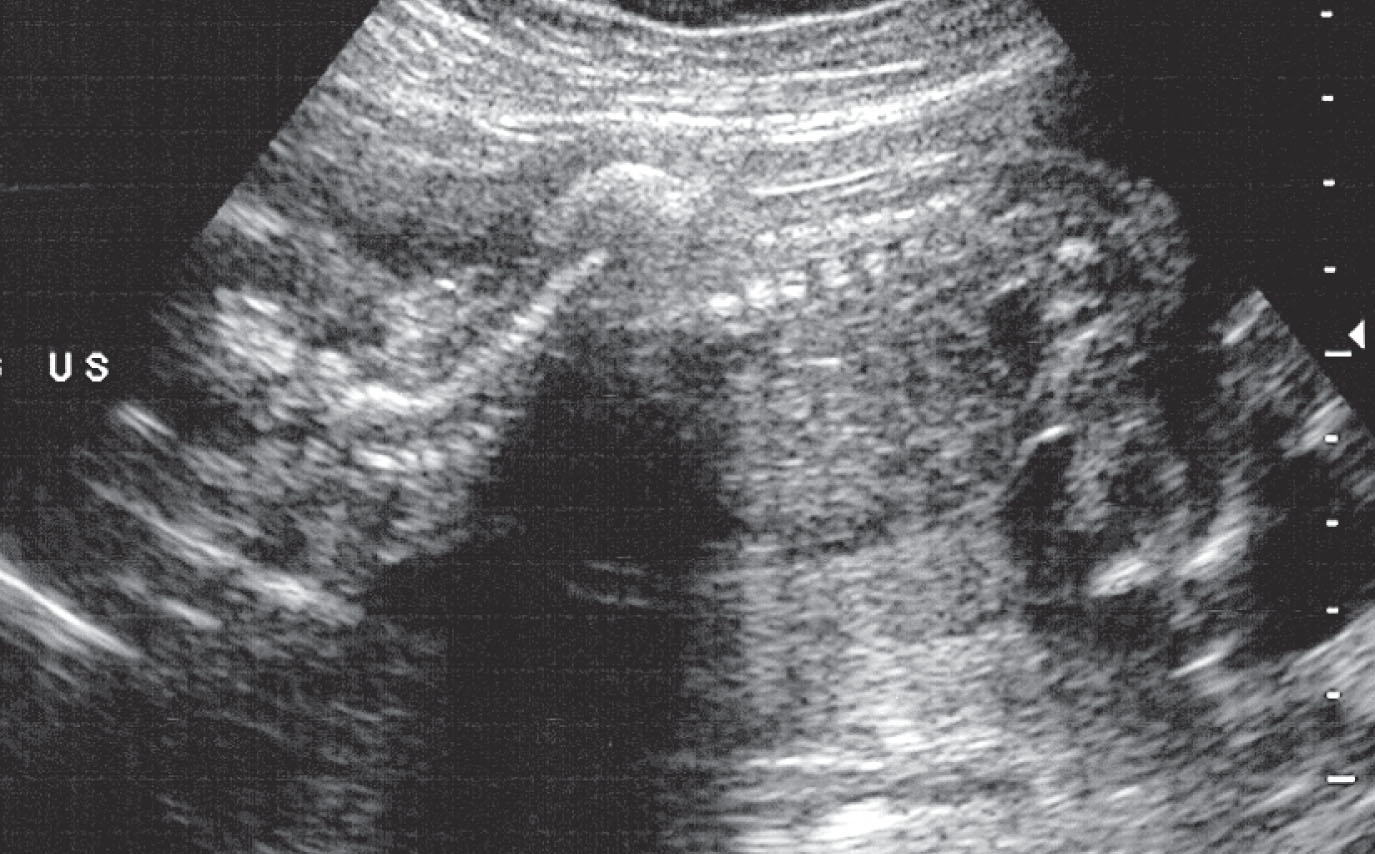
Spina bifida is also associated with varying degrees of neurologic impairment, which may include minor anesthesia, paraparesis, or death. Life-long mobility impairments result from denervation of the sensory and motor nerves at and below the spinal deformity. Fetuses with myelomeningoceles often present with cranial defects associated with the Arnold-Chiari (type II) malformation, which is identified in 90% of patients. The Arnold-Chiari II malformation invariably presents with hydrocephalus caused by the cerebellar vermis being displaced into the cervical canal. This changes the shape of the cerebellum, giving it a “banana” appearance, and leads to obliteration of the cisterna magna. In addition, caudal displacement of the cranial structures causes scalloping of the frontal bones of the skull, making the fetal head resemble a lemon, decreasing the size of the BPD.
Management of a fetus with spina bifida usually includes serial ultrasound examinations to monitor progression and extent of ventriculomegaly and to follow fetal growth. Fetuses may be delivered early for ventricular shunting, usually by cesarean section to preserve as much motor function as possible. Intrauterine surgery is considered for nonlethal conditions aimed to ameliorate the effect of advancing age on neuromuscular development and reverse hindbrain herniations. In addition to management of the actual defect, attention to any hydrocephalus, urinary tract anomalies or dysfunction, and orthopedic issues may be part of the long-term care required for this child. Risks incurred with this procedure include premature delivery, maternal morbidity, and fetal mortality. Early and accurate diagnosis is relevant for pregnancy management including planned delivery, postnatal surgery, and/or open or laparoscopic intrauterine fetal surgery, if available. Three-dimensional sonographic imaging can assist in identifying the upper level of the defect, which predicts neurologic function and mortality. In affected fetuses, 3D imaging is also useful in demonstrating the architecture of the ventricular system and cisterna magna.
Evaluation of spina bifida during the first trimester screening shares many characteristics with the second trimester assessment. However, during early gestation, the sonographer should focus on the indirect versus the direct characteristics of spina bifida. At the time of the second trimester evaluation, sonographic imaging must include a focused methodical survey of the fetal spine in both sagittal and transverse planes ( Fig. 60.14 ). The normal fetal spine should demonstrate the posterior ossification centers completing a spinal circle. Unfortunately, the survey of the fetal spine may be impeded when the spine is down, the fetus is in the breech position, oligohydramnios is present, or in cases of maternal obesity which precludes adequate visualization.
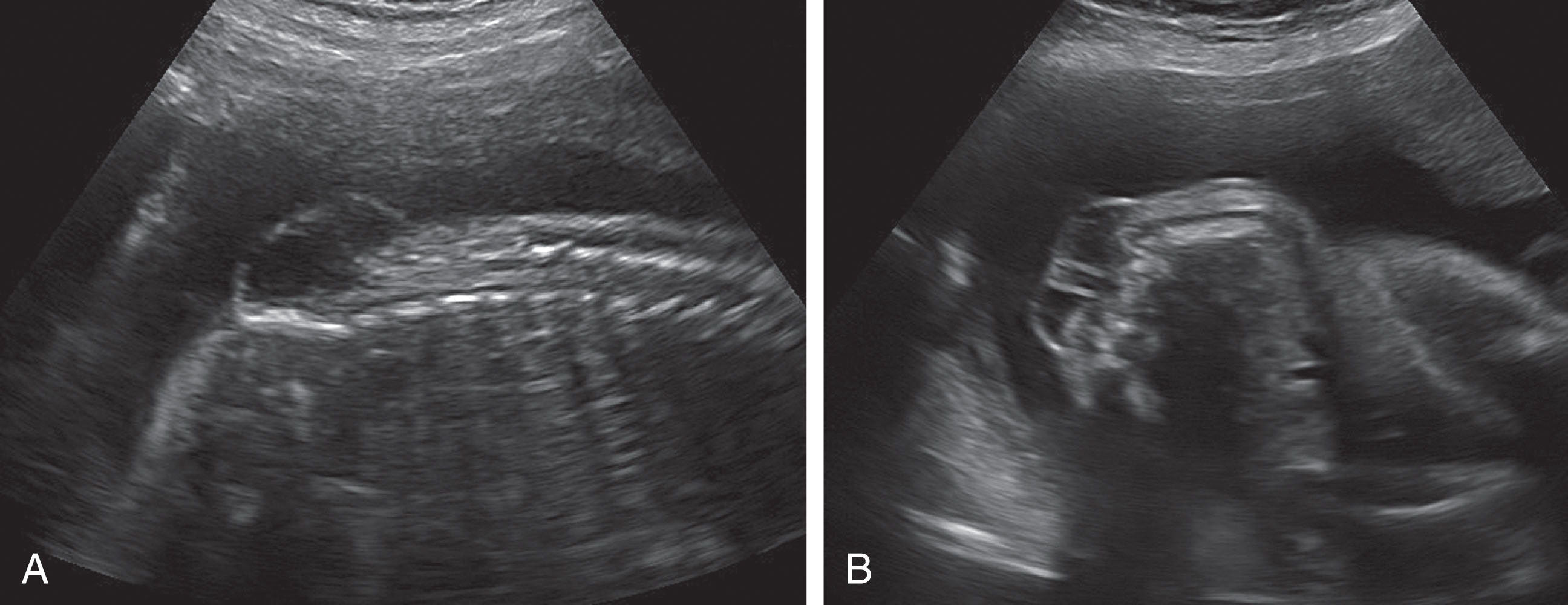
Direct sonographic features of spina bifida include the following:
Splaying of the posterior ossification centers with a V or U configuration ( Fig. 60.15 )
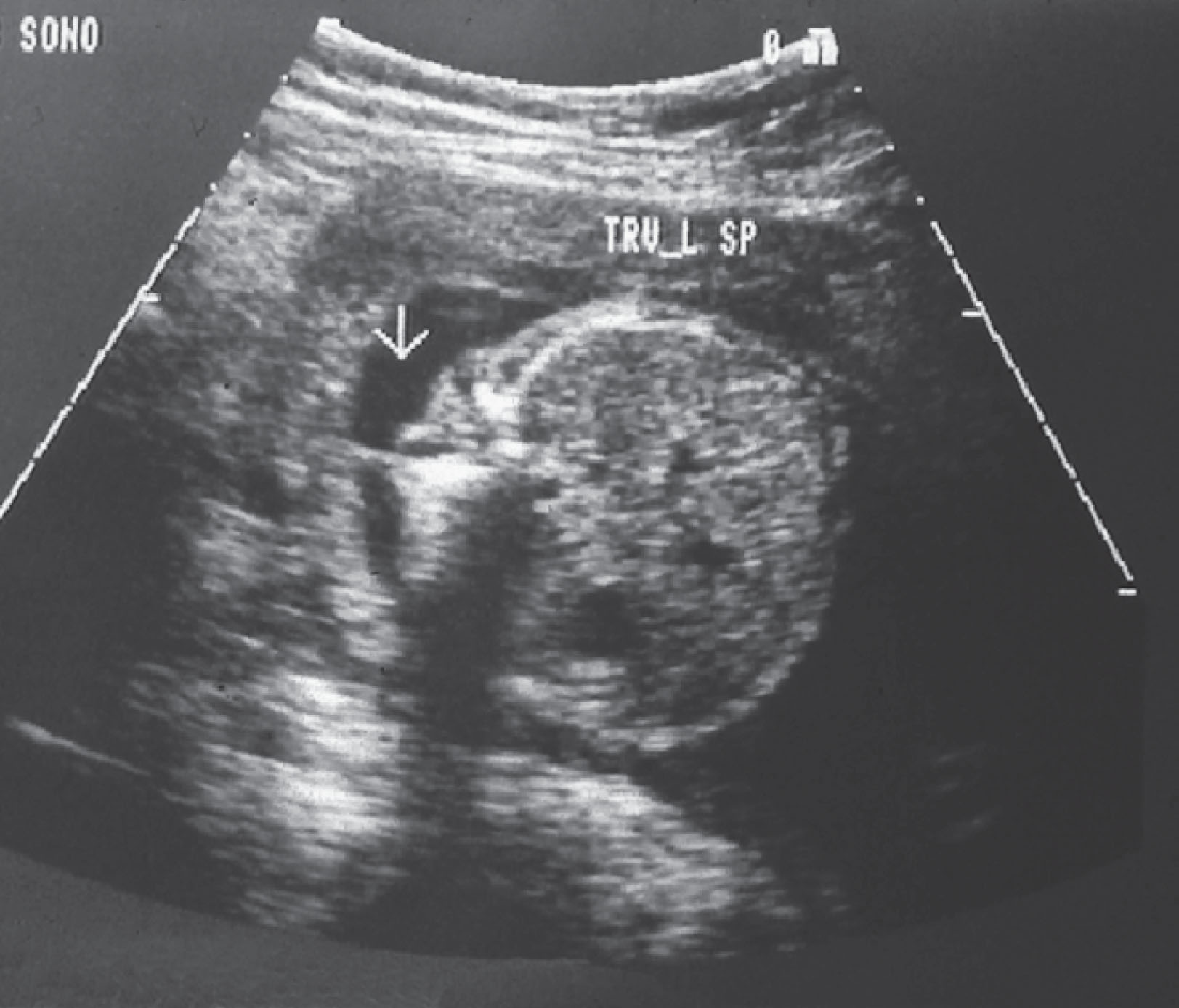
Protrusion of a saclike structure that may be anechoic (meningocele) or contain neural elements (myelomeningocele) ( Fig. 60.16 )
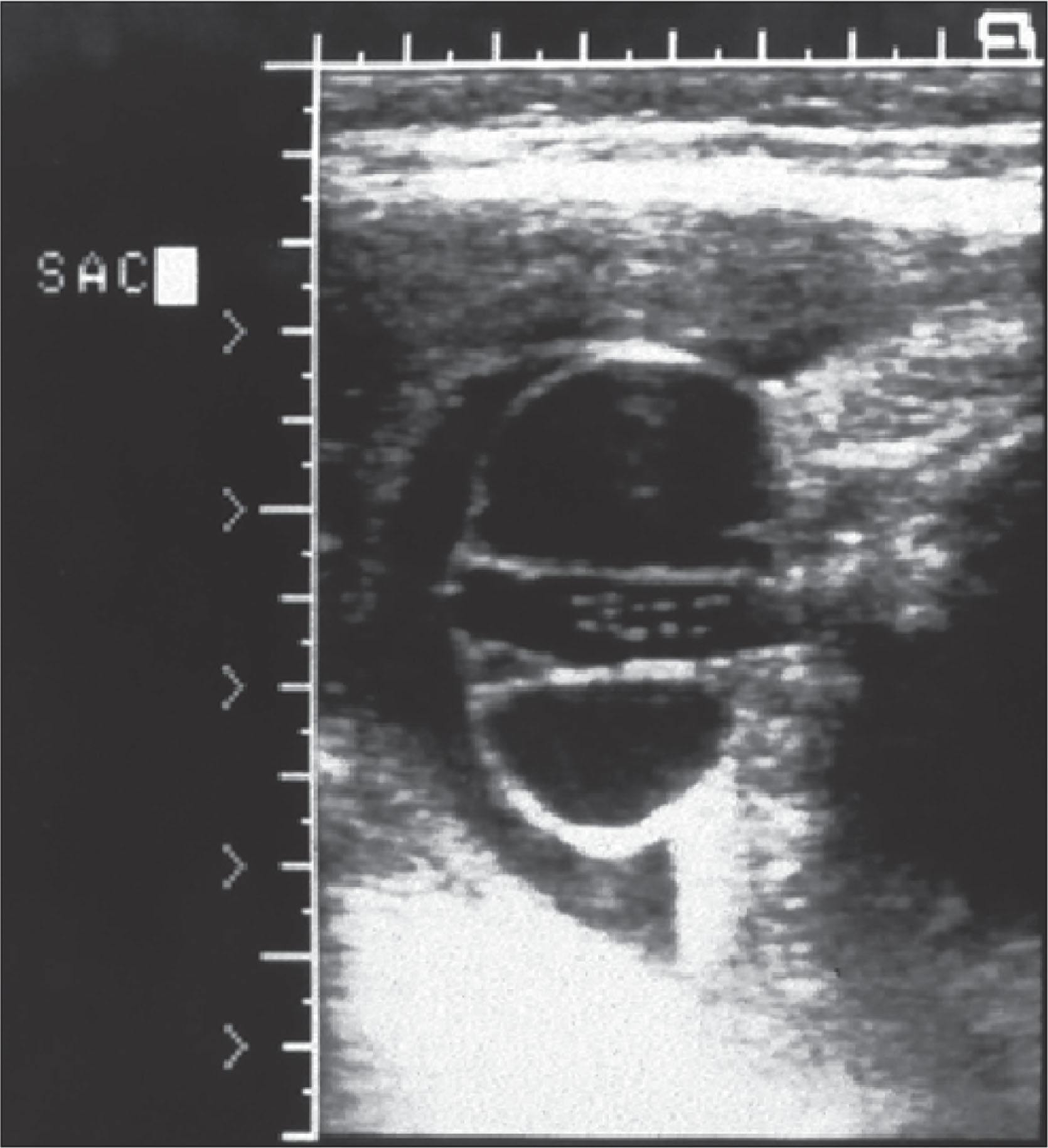
A cleft in the skin ( Fig. 60.17 )
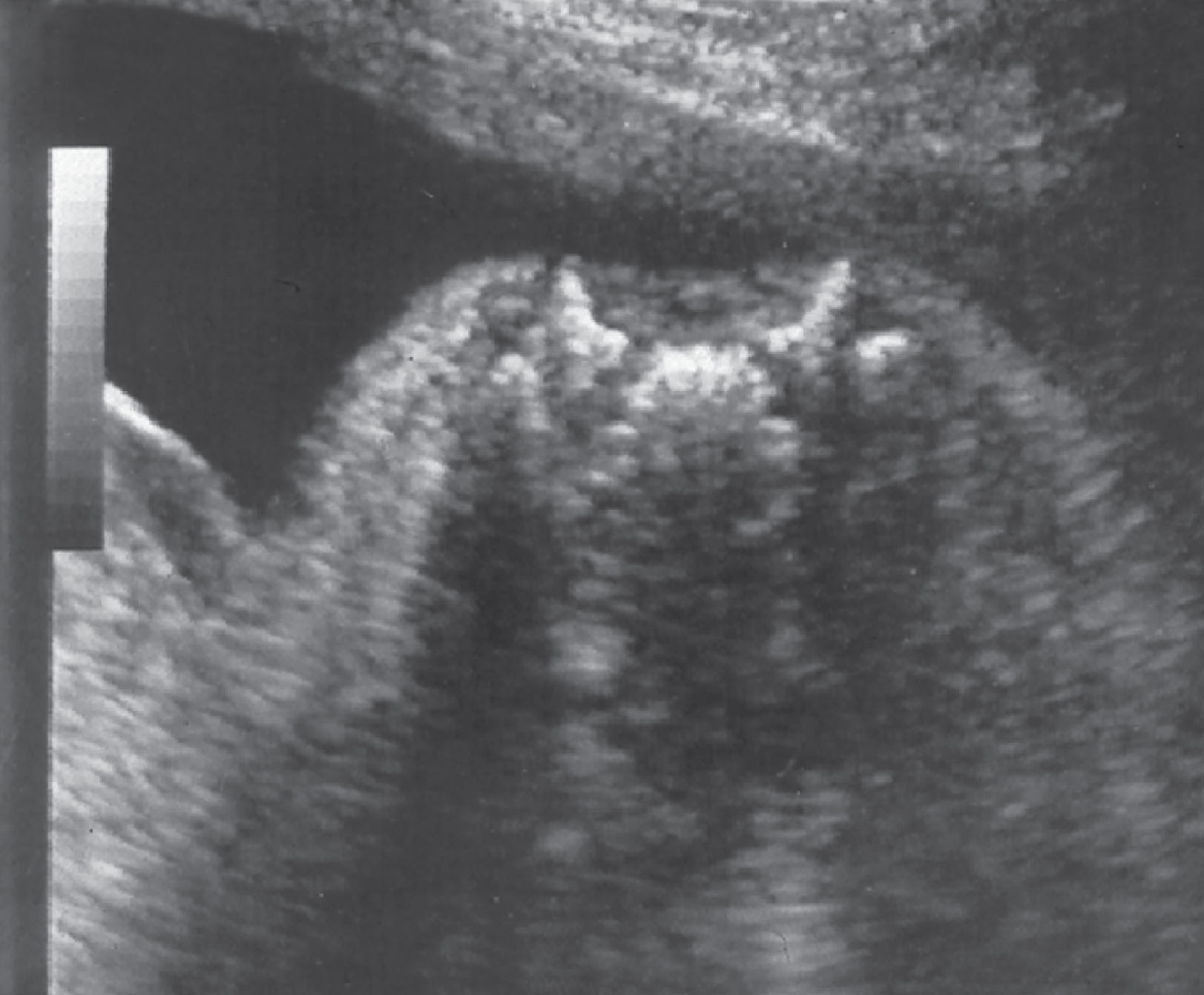
After a spinal defect has been identified, the level and extent of the defect, the presence or absence of neural elements contained in the protruding sac, and associated intracranial findings should be documented.
Indirect sonographic cranial findings include the following:
Flattening of the frontal bones, giving the head a “lemon” shape ( Fig. 60.18 )
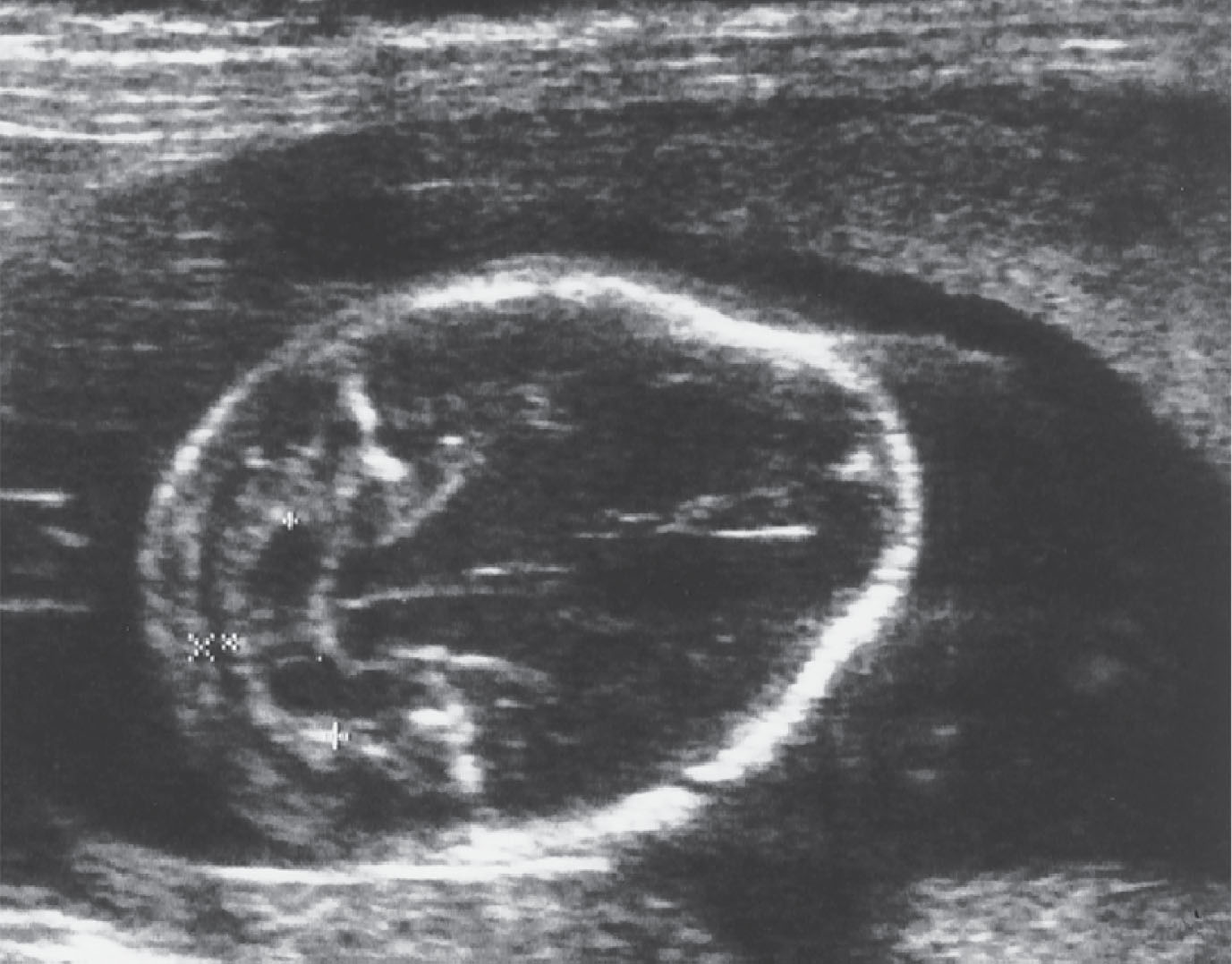
Small BPD and HC.
Obliteration of the cisterna magna and nonvisualization of the fourth ventricle
Inferior displacement of the cerebellar vermis, giving the cerebellum a rounded, “banana” shape (see Fig. 60.18 )
Ventriculomegaly ( Figs. 60.19 and 60.20 )
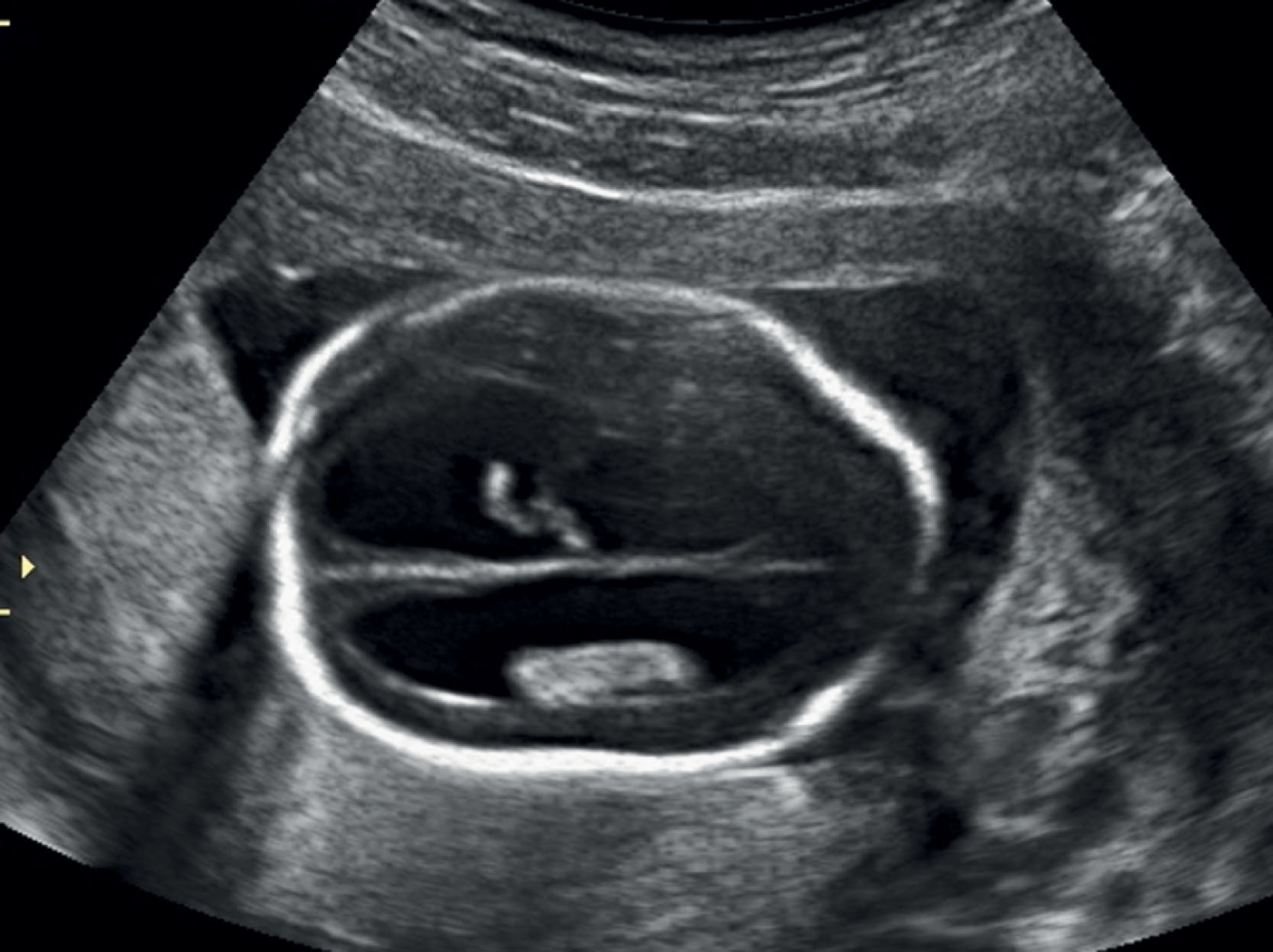
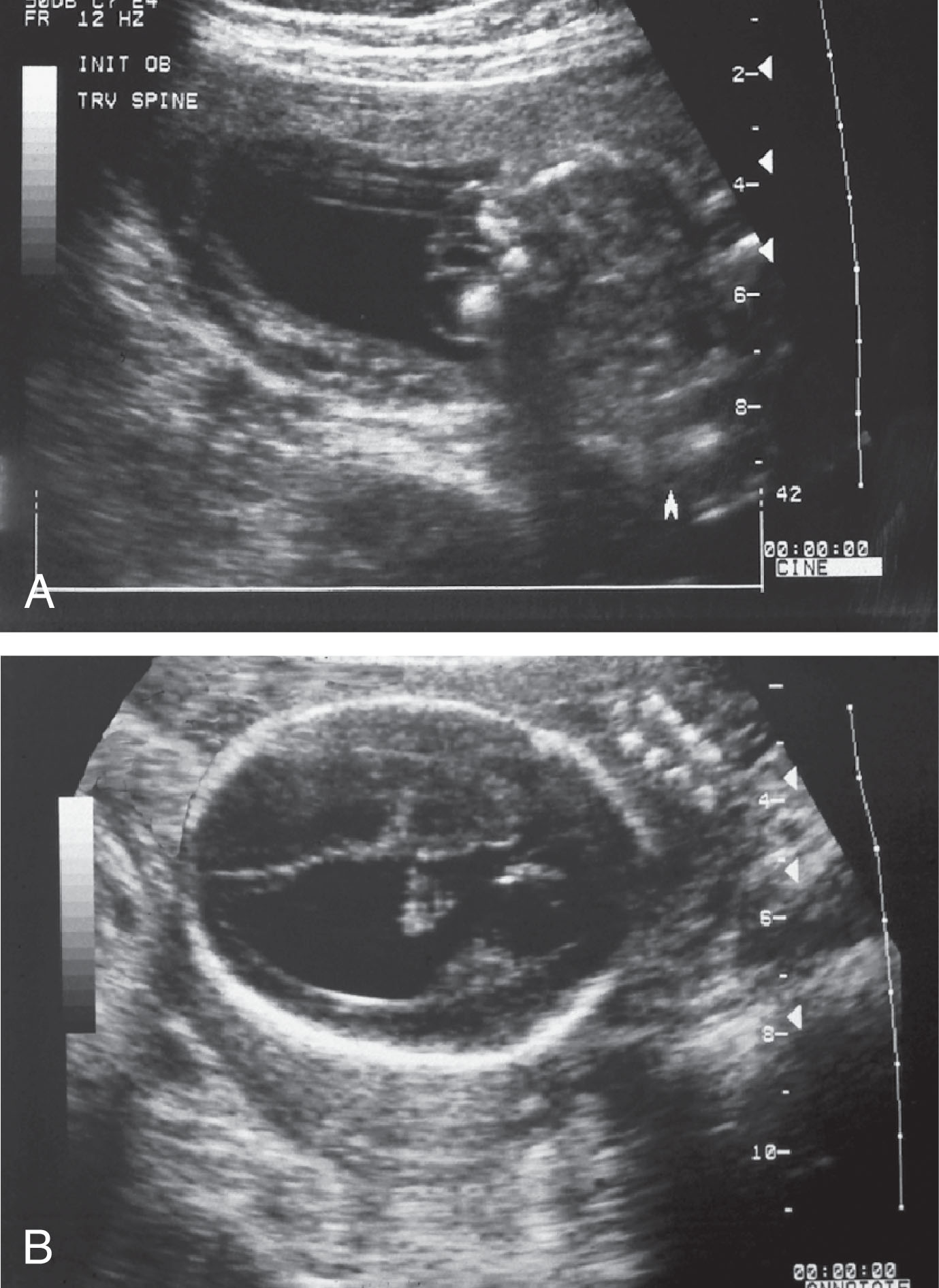
The “lemon” sign is nonspecific for spina bifida, and similar head shapes have been described with other CNS malformations, such as encephalocele, and with non-CNS malformations, such as thanatophoric dysplasia. This appearance may also be indistinguishable from the “strawberry” sign described in association with trisomy 18. Other sonographic findings associated with spina bifida include talipes, cephaloceles, cleft lip and palate, hypotelorism, heart defects, and genitourinary anomalies. Spina bifida has also been associated with multiple syndromes and chromosomal anomalies, including trisomy 18. Fetuses exposed to teratogens, such as valproic acid ( Fig. 60.21 ), carbamazepine, methotrexate, and aminopterin, are also at greater risk for developing spina bifida. Maternal diabetes, maternal obesity, hyperthermia, and folic acid deficiency have been associated with spina bifida. A family history of spina bifida or anencephaly is also a significant risk factor for the occurrence of spina bifida.
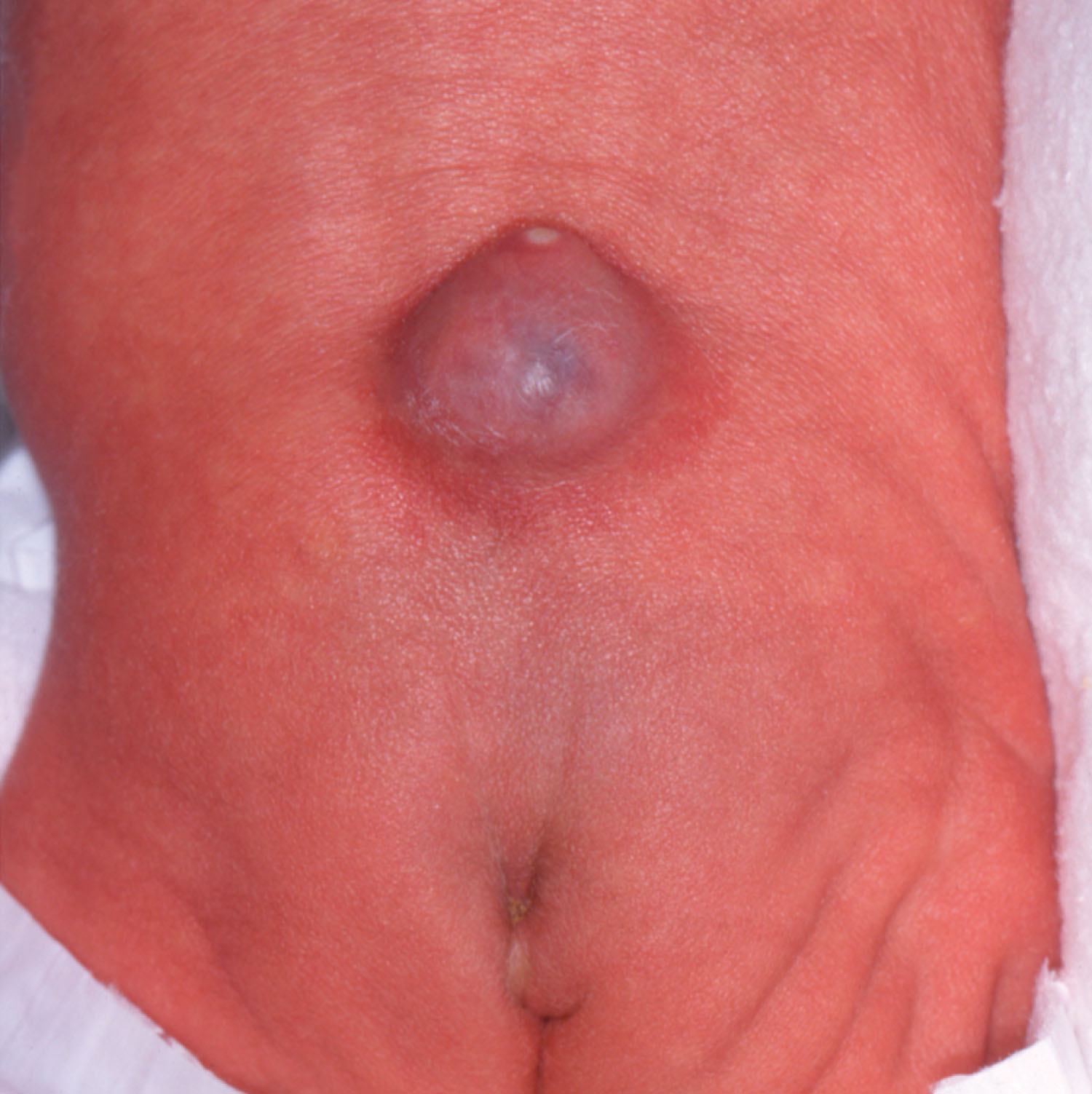
Become a Clinical Tree membership for Full access and enjoy Unlimited articles
If you are a member. Log in here